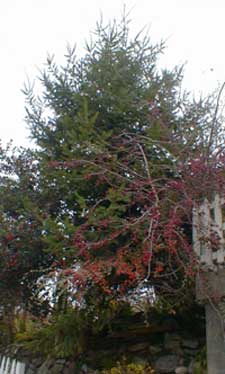 | |
| The Douglas-fir in our yard is a volunteer that grows on the cliff-edge of a retaining wall. It is much taller than our two-story house but still quite a young tree. This photo was taken in December. The spidery crooked-limbed tree or huge shrub in front of the Douglas-fir is full of red berries after leaf-fall. It, too, is a volunteer, a hawthorn which has a bizarre C-clamp shaped trunk & very crooked radiating limbs. A photo further down the page shows the tree from the opposite side gazing up, the branches heavy with January snowfall. | |
Coastal Douglas-fir
Part I: Its Majesty
"I have been many things --
A green drop in the surge, a gleam of light
Upon a sword, a fir tree on a hill."
-William Butler Yeats
(1865-1939)
(1865-1939)
Pseudotsuga menziesii var menziesii, by far the largest pine family tree, grows to 300 feet or taller & can live for a thousand years or longer. The only tree anywhere in North America that can conceivably exceed its height is the California Redwood, but what many people don't know is that the largest coastal Douglas-firs were as large as the largest giant redwood today left standing. The largest of the large grew at sea-level in maritime conditions along coastlines. This left them the easiest for loggers to reach hence the first to fall prey to greed.
Even decimated by over-exploitation, the Douglas-fir remains the most majestic of the trees native to central & coastal British Columbia, Washington Oregon, & northern California. Its range was once collectively known as Oregon Territory, so it was for a long time known as the Oregon Pine.
Inevitably encountered in its immediate understory are such gardenable companion plants as snowberry ( Symphoricarpos albus & S. mollis), evergreen huckleberry ( Vaccinium ovatum ), deciduous red huckleberry (V. parvifolium), salal ( Gaultheria shallon), Oregon grapes (Mahonia repens & other species), the Pacific rhododendron (R. macrophyllum), salmonberry (Rubus spectabilis), oceanspray (Holodiscus discolor), vine maple (Acer circinatum ), swordfern (Polystichum munitum), & many others easily adaptable to garden life. Our own gardens feature most of these wonderful native plants.
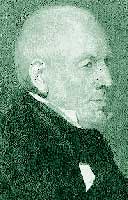 The species name is after Northwest explorer & botanist Archibald Menzies (1754-1842), who was first to describe the tree when he saw them on Vancouver Island in 1791. Archibald, shown in the portrait at right, was a Scottish physician & botanist who conducted some of his botanical investigations while a surgeon for the Royal Navy. He reached the Pacific Northwest with Captain Vancouver on the Discovery.
The species name is after Northwest explorer & botanist Archibald Menzies (1754-1842), who was first to describe the tree when he saw them on Vancouver Island in 1791. Archibald, shown in the portrait at right, was a Scottish physician & botanist who conducted some of his botanical investigations while a surgeon for the Royal Navy. He reached the Pacific Northwest with Captain Vancouver on the Discovery.The common name is after the pioneer botanist David Douglas (1799-1834). David was likewise a Scot, his portrait here at the left. On the basis of the preliminary findings of Menzies & more importantly of Lewis & Clark, Douglas knew the Northwest flora had to be exceptionally grand, & indeed he found the Northwest to possess the highest percentage of useful & beautiful temperate plant species in the world. He was responsible for introducing scores of new plant species from North America to British horticulture, chiefly from the Northwest.
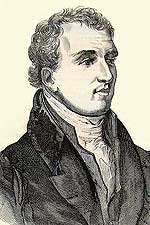 Among the flora he sent back to Britain were seeds for Sitka Spruce & Douglas-fir which were destined to reshape the timber industry of Great Britain. The largest tree in all of Britain today is near Dunkeld in the Craigvinean Forest. It is one of the very Douglas-firs planted by David Douglas.
Among the flora he sent back to Britain were seeds for Sitka Spruce & Douglas-fir which were destined to reshape the timber industry of Great Britain. The largest tree in all of Britain today is near Dunkeld in the Craigvinean Forest. It is one of the very Douglas-firs planted by David Douglas.David was a marvelous character who had spectacles strapped to his face & was always bold but not always practical in his survival skills while exploring wildernesses alone. He wandered about Oregon Territory throughout the Northwest afoot, with an Indian basket strapped to his back in which to gather plants, roots, seeds, & other botanical samples. This was before the great influx of white immigration, so he was all the more an oddity to aboriginal peoples, who named him "Walking Man Who Gathers Grass" & they were seemingly very fond of him, even where there was cause to distrust all other whites, & he seems to have been regarded as a bit addled.
On at least one occasion he stumbled out of the wilderness into a Columbia River tribal village & was near death. He was nursed back to health so that he could start afresh his inept wanderings & apt investigations. Without the good will of native peoples he would not have lived even so long as he did. When a few years later he was still gung-ho wandering about the wilds of Hawaii, he stumbled blindly into a pit wherein a wild bull gored & trampled him to death. He was only thirty-five. The place where he died is today called Kaluakauka, "The Doctor's Pit," marked by a pyramidal stone cairn.
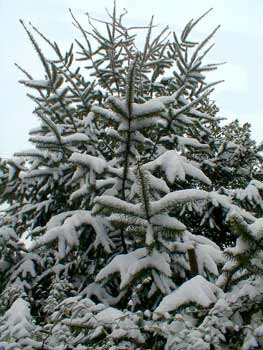 Many Northwest examples of flora & fauna bare his name; indeed, one cannot hike in any Northwest woods without encountering David's discoveries, some of which are also his namesakes, i.e., Douglas's black hawthorn, Douglas spirea, Douglas seaside tansy, Douglas's knotweed, Douglas's widow-grass, & so on, besides such fauna as the Douglas squirrel & the Douglas short-horned lizard. I regard this self-taught botanist an unusually deserving chap for so many honors. Today's David Douglas Society is today very active in the American West & Northwest, pursuing environmental interests.
Many Northwest examples of flora & fauna bare his name; indeed, one cannot hike in any Northwest woods without encountering David's discoveries, some of which are also his namesakes, i.e., Douglas's black hawthorn, Douglas spirea, Douglas seaside tansy, Douglas's knotweed, Douglas's widow-grass, & so on, besides such fauna as the Douglas squirrel & the Douglas short-horned lizard. I regard this self-taught botanist an unusually deserving chap for so many honors. Today's David Douglas Society is today very active in the American West & Northwest, pursuing environmental interests.Coastal Douglas-fir is the dominant tree all up & down the coast, throughout the Olympic National Forest, inland to the Cascade Mountains, as far south as Yosemite National Forest & inland to the Sierra Nevadas. A slightly smaller form, the Inland Douglas-fir, aka Rocky Mountain Douglas-fir (Pseudotsuga menziesii var glauca), has bluer needles & can grow higher on mountains than is generally the case with the coastal Douglas-fir. Inland Douglas-fir is commonest in the interior of the Pacific Northwest, but there are isolated forests as far as the American Southwest & deep into Mexico.
Historically (& prehistorically) Douglas-firs did not range outside of North America, but because of its appeal to the forest industry, it has been introduced into other temperate zones around the globe, such as in Scotland. In New Zealand it naturalized so thoroughly that it is is today a threat to New Zealand native trees.
The coastal Douglas-fir prefers low & middle elevations. It is insufficiently cold-hardy to dominate greater mountain heights. The further south in its natural range, the higher on mountains it will be found. When grown as a garden tree in the midwest, it tends to remain stunted at a manageable size, but is also susceptible to pests, though exceedingly hardy in its native range where it experiences wet autumns & mild winters & dry summers.
There are three Pseudotsuga species native to East Asia, & one more species in North American, the Big-cone Douglas-fir (P. macrocarpa), a rarity found only in cold canyon environments of southern California. The genus name for these five species means "False Hemlock" & they are immediately distinguishable from true hemlocks (Tsuga) in that only on Pseudotsuga do the the cones hang downward.
Besides the two natural variants of P. menziesii there are several cultivated garden forms in limited production. They are usually selected for slower growth rate & unique growth habits. These begin with "Pendula" on which the secondary branches drape downward. "Carnefix Weeping" has an more dramatic pendulous form. "Fastigata" has upreaching limbs & grows 25 to 45 feet tall. "Fletcheri" & "Nana" are dwarf spreading varieties. "Anguina" has snaking branches; "Revoluta" has curly needles; & "Stairii" has variegated needles. "Little John" is a dwarf pyramidal cultivar. There are others. Many of the cultivars are developed from the Rocky Mountain variant which is naturally more drought tolerant & cold hardy besides being smaller.
The cultivars are almost entirely grafted trees, though it is not impossible to root cuttings directly using rooting hormones & babying them along for quite some while. Because the wild trees eventually outgrow any normal sized yard, & are subject to blow-downs, the wild trees are not as safe as garden trees as are the restrained cultivars.
The needles are flat & not at all sharp; they're almost fluffy-feeling, so very garden-friendly unlike some conifers with sharp needles. If one were intentionally selecting a Douglas-fir for the yard, it should certainly be one of the restrained cultivars, as even the bigger cultivars tend to max out in the twenty to forty foot range & won't be a future threat to the house. Plus some of the cultivars are hardier when grown elsewhere than within the natural range of the species; the wild coastal Douglas-fir truly needs Northwest weather patterns.
Unfortunately most people do not go shopping for a suitable cultivar, but obtain a Douglas-fir almost by accident when obtaining a living christmas tree. Because Douglas-firs are fast-growing when young, they are in production as both cut trees & living trees to sell by the hundred-score over the holidays. Families that rightly come to feel bad for having had a family tradition of watching cut tree slowly wither away in their living room each winter decide instead to obtain a living tree that can after the holidays be put out into the yard. Whether it is a Norfolk pine or a Douglas-fir, if it survives the holiday manhandling & indoor temperatures in order to survive thereafter in the garden, it will in the long run prove to be far too large for the average yard. By contrast, a carefully chosen dwarf or semi-dwarf cultivar chosen could've been just the thing forever.
The other way of getting a wild tree in your yard is to live in their natural range & have one appear spontaneously. For us this is a locally native wild tree which self-seeded itself probably around twenty years ago, for it is growing on a little cliff ledge where no one would have intentionally planted it even when it was small. Its mother could well still be alive, as a few vastly older Douglas-firs stand together in a group a scant half-block away as part of our view.
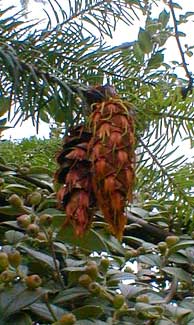 Old trees have gorgeous furrowed bark but young trees have smooth grey bark. Though ours is quite a bit taller than the house & gaining a foot or so each year, it is nevertheless young for a Douglas-fir, so has the smooth bark. It is barely old enough to be producing cones; in fact, 2004 was the first year that it was covered all over with cones, instead of just a few scattered high in branches. The cones are green for much of the year, turning brown when fully mature in August or September, often with a slight curve to them. A September cone is shown on this page.
Old trees have gorgeous furrowed bark but young trees have smooth grey bark. Though ours is quite a bit taller than the house & gaining a foot or so each year, it is nevertheless young for a Douglas-fir, so has the smooth bark. It is barely old enough to be producing cones; in fact, 2004 was the first year that it was covered all over with cones, instead of just a few scattered high in branches. The cones are green for much of the year, turning brown when fully mature in August or September, often with a slight curve to them. A September cone is shown on this page.Between each of the papery scales is a triple-pronged bract that looks like the two hind feet & tail of a teency mouse which has its head poked inside the cone. As a child I imagined these mouse-rump bracts looked like the trident tongues of dragons, so a name to match the majesty of the trees could've been "Dragon-tongue Fir," although if imagination had run free for common names it could've just as easily ended up called the "Mouse Butt Fir."
The majority of their single-winged seeds are wind-dispersed by the end of October. The emptied papery-scaled cones cling to the trees for many months after seed dispersal.
The single-winged seeds are a major food resource for chipmunks, voles, deermice, wrens, sparrows, redwinged crossbills, dark-eyed juncos, Clark's nutcrackers, purple finch, & other small mammals & birds. The Douglas squirrel gathers & stores huge quantities of Douglas-fir cones. Blue grouse include the needles as a major component of their diet. Deer & elk browse Douglas-fir seedlings or newest growth in spring. Old growth Douglas-firs provide the primary habitat of the spotted owl & red tree vole, the latter's specialized diet consisting almost exclusively of Douglas-fir needles.
Continue to:
Part II: Exploitation of the Douglas-fir